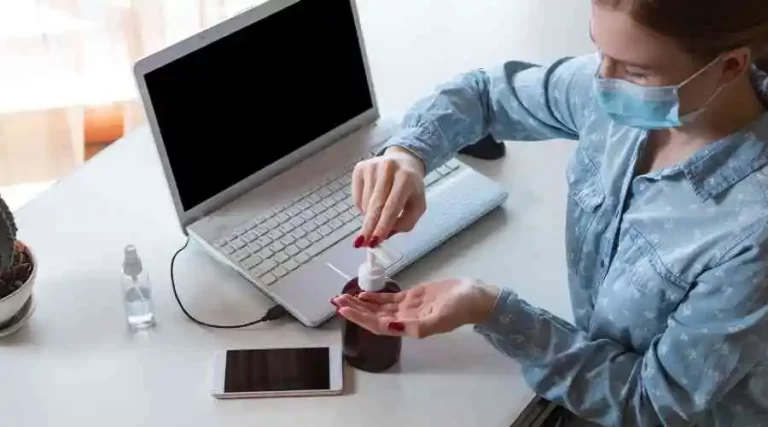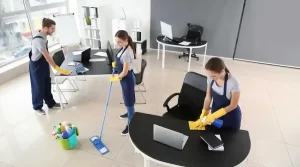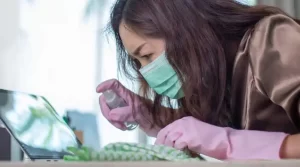Consider how much time you spend with your electronic devices, which range from computers, keyboards, mice, copiers, and printers, to phones and headsets. We use them all the time, both in our personal and professional life.
Disinfecting electronic equipment is more vital than ever, particularly given the enormous effect of COVID-19. From the specialists at BJC Carpet Cleaning Jersey City, you’ll discover all you need to know about cleaning and sanitizing electronic equipment safely and efficiently in this thorough guide.
What is the significance of cleaning and disinfecting electronic equipment?
Germs and bacteria are abundant in electronic equipment. According to research, keyboards, mouse, and other workplace equipment may be up to ten times more filthy than a toilet seat! With all the time we spend using electronic devices, it’s no surprise that so many people get ill each year from avoidable ailments like the common cold and flu. Because of the epidemic, cleanliness is essential.
(1) Cleaning and sanitizing electronic equipment is essential for two reasons: preventing the transmission of disease-causing bacteria and protecting the device from harm. Dust, grit, and grime may accumulate on electrical equipment over time, leading it to malfunction or fail. Extend the life of your electronic equipment by cleaning and sanitizing it regularly.
What substances are not harmful to electronics?
On the market, there are several cleansers and disinfectants that claim to be safe for electronics. However, they are not all made equal. Because certain cleaners may harm electronic equipment, it’s critical to choose one that’s mainly intended for cleaning electronic equipment.
Isopropyl alcohol, popularly known as rubbing alcohol, is a popular and efficient disinfectant for electronics.
(2) This disinfectant is safe on most electronic devices and is highly powerful at destroying germs and bacteria. To achieve the most outstanding results, go for an isopropyl alcohol disinfectant with at least 70% alcohol.
Hydrogen peroxide is another safe and efficient disinfectant for electronics. Because it is mighty at destroying germs and bacteria, this disinfectant is often used in hospitals and other medical environments. To get the most outstanding results, use a hydrogen peroxide disinfectant with a concentration of at least 3%.
Procedures to follow before cleaning and sanitizing electronic equipment
- Begin by carefully washing your hands with soap and water to eliminate dirt or germs.
- Unplug any electronic devices from power outlets. When cleaning a computer, keyboard, or mouse, disconnect it from the computer and turn it off.
- Remove any batteries from your electrical devices. Because cleaning solutions might harm batteries, it is essential to remove them before cleaning.
- Gather all necessary items, including disinfection wipes or spray, gloves, and a microfiber cloth.
- Make sure that the location in which you are working is well-ventilated.
- Take the electrical equipment outdoors if feasible. This will prevent any toxic chemicals or fumes from harming the equipment.
- Tape over any exposed circuitry or electrical components. This will shield them from injury as you clean and disinfect them.
Cleaning and disinfecting a computer display, keyboard, and mice
Disinfecting monitor:
- Wipe the monitor clean with a disinfectant wipe or spray a disinfectant into a microfiber cloth and wipe the screen clean. Make careful not to get any cleaner on the bezel (the frame around the screen).
- Remove any cleaning that has gotten on the bezel using a clean, dry microfiber cloth.
- Use a glass cleaner and a dry microfiber cloth to polish the screen.
Disinfecting keyboard:
- Shake the keyboard upside down to remove any loose dirt or debris.
- Wipe off the keys with a disinfectant wipe or a disinfectant sprayed onto a microfiber cloth. Make sure you get between the keys.
- Remove any cleaning that has gotten on the keys using a clean, dry microfiber cloth.
- Use a glass cleaner and a clean, dry microfiber cloth to polish the keys.
- It is only sometimes a good idea to remove the keys. However, removing the keys is simple if it’s safe and you want that additional degree of cleanliness. Shake the keyboard upside-down to remove any loose dirt or debris, then turn it back upright. pry the keys with a flathead screwdriver or a similar tool, clean them with a disinfectant wipe, spray them with a disinfectant, and let them air dry.
Disinfecting mouse:
- Use a disinfectant wipe to clean the mouse’s surface, or spray a disinfectant onto a microfiber cloth and then wipe it off.
- Clean any dirt or debris between the buttons using a toothpick or cotton swab.
- Using a clean, dry microfiber cloth, remove any cleaning that has gotten on the mouse.
- Utilizing a dry microfiber towel and glass cleaner, polish the mouse.
Cleaning and disinfecting copiers and printers
Disinfecting copier:
- Please turn off the copier and unhook it from the power supply.
- Take any paper out of the copier.
- Open all the copier’s doors and compartments to access all the surfaces that need to be cleaned.
- Wipe all surfaces with a disinfectant wipe, or spray a disinfectant onto a microfiber cloth and wipe it down. Cleaning the control panel, touch screen, buttons, and other surfaces that come into contact with your hands is essential.
- Clean any dirt or debris between the keys or buttons using a cotton swab or toothpick.
- Remove any cleaner that has gotten on the copier using a clean, dry microfiber cloth.
- Use a glass cleaner and a dry microfiber cloth to polish all surfaces.
- Restart the copier and reconnect it to the power supply.
Disinfecting printer:
- Please turn off the printer and unhook it from the power supply.
- Take any paper out of the printer.
- Open all the printer’s doors and compartments to access all the surfaces that need to be cleaned.
- Wipe all surfaces with a disinfectant wipe, or spray a disinfectant onto a microfiber cloth and wipe it down. Cleaning the control panel, touch screen, buttons, and other surfaces that come into contact with your hands is essential.
- Clean any dirt or debris between the keys or buttons using a cotton swab or toothpick.
- Remove any cleaner that has gotten on the printer with a clean, dry microfiber cloth.
- Use a glass cleaner and a dry microfiber cloth to polish all surfaces.
- Restart the printer and reconnect it to the power supply.
- Cleaning and disinfecting phones and headsets
Disinfecting phones:
- Turn off the phone.
- Remove the battery and SIM card if possible.
- Wipe all surfaces with a disinfectant wipe, or spray a disinfectant onto a microfiber cloth and wipe it down. Cleaning the screen, buttons, and any other surfaces that come into touch with your hands is essential.
- Clean any dirt or debris between the keys or buttons using a cotton swab or toothpick.
- Remove any cleaner that has gotten on the phone using a clean, dry microfiber cloth.
- Polish all surfaces with glass cleaner and a dry microfiber cloth.
Turn on the phone after replacing the battery, if possible.
- Remove the headset.
- Take out the battery (if possible).
- Wipe down all surfaces with a disinfectant wipe or spray a disinfectant on a microfiber cloth and wipe it down. Cleaning the earpieces, buttons, and other surfaces that touch your skin is essential.
- Clean any dirt or debris between the keys or buttons using a cotton swab or toothpick.
- Remove any cleaning that has gotten on the headset using a clean, dry microfiber towel.
- Use a glass cleaner and a dry microfiber cloth to polish all surfaces.
- Replace the battery (if feasible) and switch on the headset.
- How to clean and disinfect a laptop
Disinfecting the exterior:
- Use a disinfectant wipe to clean the monitor or a microfiber cloth sprayed with a disinfectant to clean the screen. Make careful not to get any cleaner on the bezel (the frame around the screen).
- Wipe down the keyboard with a disinfectant wipe or a disinfectant sprayed onto a microfiber cloth. Make sure you get between the keys.
- Use a disinfectant cloth to clean the touchpad, or spray it with the cleaner before wiping it down.
- Remove any cleaner that has called on the display, keyboard, or touchpad using a clean, dry microfiber cloth.
- Use a glass cleaner and a dry microfiber cloth to polish the screen.
- To clean the keyboard, use a dry microfiber cloth and glass cleaner.
Cleaning the interior:
- Blow any dust or debris from the gaps between the keys using compressed air.
- Wipe down the keyboard with a disinfectant wipe or a disinfectant sprayed onto a microfiber cloth. Make sure you get between the keys.
- Wipe down the touchpad with a disinfectant wipe or spray it with disinfectant and wipe it down.
- Clean any dirt or debris between the buttons using a cotton swab or toothpick.
- Remove any cleaner that has gotten on the keyboard or touchpad using a clean, dry microfiber cloth.
- Use a glass cleaner and a dry microfiber towel to polish the keyboard.
Is UV valuable light for disinfecting electronic devices?
UV light disinfection is a common way of cleaning electronics. However, there is no scientific proof that UV light disinfection works to eliminate germs and bacteria. Indeed, several studies have shown that UV radiation may harm electronic devices. (3)
If you decide to employ UV light disinfection, do it correctly. To begin, disconnect the item from any power source. Next, place the UV light at least six inches away from the apparatus. Please turn on the UV light and leave it on for at least two minutes to disinfect the equipment. After disinfecting the equipment, ensure it is thoroughly dry before using or storing it.
What not to do when cleaning and sanitizing electronics
When cleaning and sanitizing electronic equipment, there are a few things you should avoid doing.
- Cleaners and disinfectants that are not mainly intended for cleaning electronic equipment should not be used. These cleaners have the potential to harm the equipment.
- Never immerse electrical equipment in liquids. This may cause the equipment to be damaged and invalidate any warranties.
- UV light disinfection should not be used on any electronic equipment with sensitive surfaces, such as LCDs. UV radiation has the potential to harm these surfaces.
- Use no strong chemicals, such as bleach, on electrical equipment. These substances have the potential to harm electronics.
- Do not clean electronic equipment using pressurized air. The pressurized air may drive dirt and dust into the equipment, causing it to break down.
How often should electronic devices be disinfected?
It is critical to disinfect electronic equipment regularly, mainly if numerous persons use it. However, if you utilize electronic equipment in a hospital context or someone unwell has used it, you should disinfect it more often.
If someone who uses the equipment becomes unwell, disinfect it as quickly as feasible. The kit should also be disinfected if it touches body fluids such as blood or saliva.
What are the advantages of cleaning and sanitizing electronic equipment regularly?
Regularly cleaning and sanitizing electronic equipment may assist in reducing the spread of sickness in the workplace. You may assist in minimizing the number of sick days taken by workers by cleaning the equipment. This may boost workplace productivity and morale.
It also increases the lifespan of your electrical devices. Cleaning the equipment regularly can avoid accumulating dirt and dust, which can harm the electronics over time. Use these guidelines to thoroughly clean and disinfect your electronic equipment.
Do you need Professional help?
BJC Carpet Cleaning Jersey City cleans business premises, including the most delicate regions and equipment. It is more crucial than ever for workers and consumers to feel comfortable and for disinfection to be prioritized. Remove the burden of cleaning yourself or worrying whether your company is clean. Contact the team at 315 Sip Ave, Jersey City, NJ 07306, for more information.





